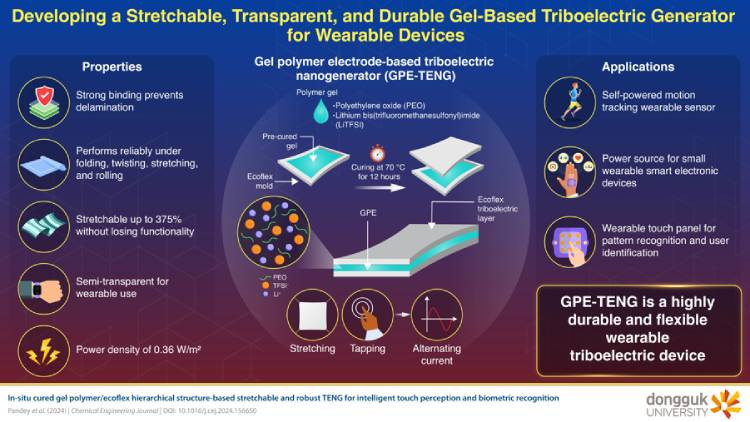Gel Triboelectric Nanogenerator Powers Wearable Devices
Insights | 07-01-2025 | By Robin Mitchell

While traditional batteries have been used to power such devices, the need for sustainable and long-lasting energy sources has led to the exploration of alternative solutions. Recently, researchers at Dongguk University have made a notable breakthrough in the field of triboelectric nanogenerators (TENGs), which convert mechanical energy into electrical energy.
Key Things to Know:
- Breakthrough in Wearable Power Generation: Researchers at Dongguk University have developed a gel polymer-based triboelectric nanogenerator (GPE-TENG) capable of generating electrical signals from body movements, providing a sustainable power source for wearables.
- Highly Stretchable and Durable Design: The GPE-TENG can stretch up to 375% of its original size while withstanding mechanical stress, making it ideal for applications in clothing and medical wearables.
- Potential for Biometric and Healthcare Applications: This technology enables real-time health monitoring and secure biometric authentication, enhancing both personal security and healthcare management.
- Future-Ready for Advanced Applications: With further enhancements, the GPE-TENG could power larger devices and integrate with energy storage systems, expanding its use in wearable technology and extreme environments.
What challenges do wearables face, what did the researchers develop, and what are the implications of the gel polymer-based triboelectric nanogenerator developed by the research team?
What challenges do wearables face?
Wearable devices have been around for a number of years, but while they have gained in popularity, they are far from being truly wearable. Most wearables are solid devices, often being tied to a wrist or worn as headgear, but in the sense of wearable, such devices do not exist yet.
No devices have been integrated into clothing, move naturally with the human body, can be repeatedly washed, and resist damage against constant flexing and stretching. All of these challenges come as a result of the solid nature of electronics, being made from solid materials such as metal, plastic, and semiconductor crystals.
While many flexible components have been developed, they are rarely suitable for commercial devices, and they almost never have the necessary capabilities needed from commercial devices such as processing power, current handling etc. The lack of flexible components also affects the power sources used in wearable devices. To date, no flexible power source has been developed that could power a typical wearable.
As such, all wearable devices are reliant on ridged technologies, and this seriously limits their capabilities.
Dongguk University Develops Gel-Based Stretchable Triboelectric Nanogenerators
In a new achievement, researchers at Dongguk University have successfully developed a gel polymer-based triboelectric nanogenerator that generates electrical signals from body movement. This advanced device not only powers electronics like LEDs but also functions as a self-powered touch panel for user identification.
Advancements in Gel-Based Nanogenerator Technology
The nanogenerator can stretch up to 375% of its original size and withstand rigorous mechanical deformations, making it an ideal candidate for wearable applications. The research team, led by Professor Jung Inn Sohn, has addressed one of the primary challenges faced by triboelectric nanogenerators (TENGs) used in wearable applications.
One of the unique features of this innovation is its adaptability to different wearable scenarios. For example, the GPE-TENG can be seamlessly integrated into clothing fabrics, offering possibilities for continuous health monitoring or biometric security systems embedded within everyday apparel. This adaptability positions the technology as a key enabler for the next generation of intelligent wearables, expanding the scope of applications beyond personal healthcare to include industrial and security contexts.
Adaptability for Diverse Wearable Scenarios
Most TENGs incorporate a triboelectric material attached to an electrode that conducts current, but finding flexible electrode materials that can move effortlessly with the human body has been a major hurdle. To overcome this challenge, the researchers developed a gel polymer electrode-based triboelectric nanogenerator (GPE-TENG) that is stretchable, semi-transparent, and durable.
Innovative Approach to Overcoming Design Challenges
The fabrication process involves pouring a gel mixture of polyethylene oxide (PEO) and lithium bis(trifluoromethanesulfonyl)imide (LiTFSI) into an EcoFlex mold. The gel is then spread evenly and covered with another EcoFlex layer, followed by the attachment of copper wire for electrical connection.
The entire assembly is cured at 70°C for 12 hours, allowing the gel to bond strongly with the EcoFlex layers. The resulting device is a durable, flexible, and semi-transparent nanogenerator that generates electrical signals when tapped or stretched. The device delivers a peak power of 0.36 W/m² at a load of 15 Mohms and can stretch up to 375% of its original size without damage.
Future iterations of this technology could focus on enhancing the power output to support more energy-intensive applications. This includes integrating advanced materials to improve charge density or coupling the nanogenerators with energy storage systems like supercapacitors. Such enhancements would extend the usability of GPE-TENGs to power larger devices, making them a versatile component of the wearable tech ecosystem.
Future Enhancements for Expanded Applications
The breakthrough development of the GPE-TENG aligns with the growing demand for sustainable energy solutions in wearable technology. This innovation is particularly significant for applications such as advanced medical rehabilitation devices and real-time biometric systems. By harnessing the natural movements of the human body, the device transforms kinetic energy into a reliable power source, reducing the dependence on traditional batteries. This achievement underscores Dongguk University's commitment to eco-friendly technological advancements, further solidifying its position as a leader in wearable electronics research.
Eco-Friendly Innovations for Wearable Technology
Furthermore, the device can withstand two months of bending, twisting, folding, and stretching without any signs of delamination or loss of electrical performance. The proposed GPE-TENG has the potential to advance wearable technology, enabling devices that track joint activity for rehabilitation purposes or serve as biometric systems in clothing.
These durability traits are pivotal for applications in extreme environments, such as outdoor expeditions or military operations. The ability to sustain mechanical stress while maintaining performance makes the GPE-TENG a reliable choice for wearables used in harsh conditions. Additionally, its robust design could facilitate its use in emergency response gear, where dependable power sources are critical for communication and navigation tools.
Applications in Extreme and Critical Environments
These devices could allow users to unlock smart doors or lockers with a simple tap, making daily life more convenient and efficient. According to Professor Sohn, "This work could greatly enhance wearable technology by developing sustainable and flexible electronic devices with promising applications in human healthcare, rehabilitation, security systems, and secure biometric authentication systems."
Moreover, the GPE-TENG’s semi-transparent and stretchable properties open avenues for innovative designs in fashion technology. Imagine garments that not only monitor health metrics but also generate electricity to power small personal devices, such as hearing aids or smart glasses. This would revolutionise the way we perceive wearable technology, merging aesthetics with functionality in a sustainable manner.
Could these wearable TENGs be the future of wearable power?
While the new device is a major breakthrough in wearable technology, it still faces numerous challenges that need to be addressed. One of the biggest challenges faced by TENGs is their low watt density.
This means that they are only able to generate a small amount of electricity, making them unsuitable for powering large devices. As such, TENGs are only able to power small devices such as sensors and microcontrollers.
However, the low watt density of TENGs also makes them ideal for use in energy-harvesting applications. Energy harvesters are devices that are able to extract energy from the environment and store it for later use. In the case of TENGs, they can be used to generate electricity when a device is in use, and then store that energy for later use. This can be particularly useful for devices that only require a small amount of power to function, such as sensors and microcontrollers.
While they still face numerous challenges, they have the potential to provide a reliable and efficient power source for wearable devices. As such, researchers will continue to explore the use of TENGs in wearable devices, and it is likely that we will see the first commercial devices in the next few years.

